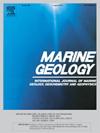Major Holocene glacio-isostatically-induced earthquakes triggered mass-transport deposits and seabed displacements in Lake Melville
IF 2.6
3区 地球科学
Q2 GEOSCIENCES, MULTIDISCIPLINARY
引用次数: 0
Abstract
The character and history of post-depositional structures within Lake Melville, Labrador, Canada, is investigated from a geohazard and sedimentary process perspective. Large Holocene earthquakes during glacio-isostatic recovery generated large (up to 3.1 km3) contemporaneous failures across up to 7 separated basins, and earthquake-related markers including vents, pockmarks, diapirs, stratigraphic offsets, and massive liquefaction fronts. Epicenter locations within Lake Melville are identified for three ∼7 ± ML magnitude Holocene earthquakes. Deposits include a massive 3.1 km3 turbidite MT event at ∼7 ± 0.3 kyr BP, the up to 1.1 km3 mega debris flow DF1 event at ∼6 ± 0.2 kyr BP, and the equally large 1750 ± 50 CE DF2 event. Mega-debris flow theory is revised to include seafloor liquefaction beneath the path of the mass flow, debris-flow bulking by incorporating underlying sediments, and shock-front compression for failures with large drop heights. During the DF1 event, 68 km2 of the seafloor collapsed forming fault-strike mega-pockmarks or vents, with 40 % contemporaneously buried by mega debris flows. The collapse volume is associated with ∼5000 large sand or mud diapirs (∼0.2 Gt) at a spatial density of 5 ± per km2 across well-separated basins. The DF2 event created a 0.11 km3 prodelta channel that since 1750 CE serves largely as a bypass zone for a growing 0.01 km3 sandy turbidite fan. Lake Melville's tendency towards thixotropic sediment failure reflects high basin-filling accumulation rates (3+ cm per yr) and the presence of buried and over-pressured low-cohesion sandy-silt layers. Mega debris flows in Lake Melville remobilized and entrained substrate during transport, more than doubling their original failure volume. Tsunami wave amplitude predictions may be over-estimated by up to 75 %, if incorrectly based on deposit volume rather than the originating slope failure. Maximum tsunamis amplitude estimates for Lake Melville fall between ∼23 m and ∼ 69 m.
全新世冰川均衡诱发的大地震引发了梅尔维尔湖的物质搬运沉积和海底位移
从地质灾害和沉积过程的角度研究了加拿大拉布拉多梅尔维尔湖沉积后构造的特征和历史。冰川-均衡恢复期间的全新世大地震在多达7个分离盆地中产生了大型(高达3.1 km3)的同期破坏,以及与地震相关的标志,包括通风孔、麻坑、底辟、地层偏移和大规模液化前缘。在梅尔维尔湖内确定了3 ~ 7±ML级全新世地震的震中位置。矿床包括在~ 7±0.3 kyr BP的巨大3.1 km3浊积岩MT事件,在~ 6±0.2 kyr BP的高达1.1 km3的巨型泥石流DF1事件,以及同样大的1750±50 CE DF2事件。巨型泥石流理论被修订,包括在质量流路径下的海底液化,通过结合下面的沉积物形成的泥石流膨胀,以及大落差高度的冲击前压缩。在DF1事件期间,68平方公里的海底塌陷形成了断层走向的巨型坑或喷口,其中40%同时被巨型泥石流掩埋。崩塌体积与约5000个大型砂或泥底辟(约0.2 Gt)有关,在分隔良好的盆地中,其空间密度为5±每平方公里。DF2事件形成了一个0.11 km3的前三角洲河道,自1750年以来,该河道在很大程度上充当了一个正在增长的0.01 km3砂质浊积扇的旁路带。梅尔维尔湖的触变沉积物破坏趋势反映了高的盆地填充堆积速率(每年3+ cm)和埋藏和超压低粘聚砂粉层的存在。梅尔维尔湖的巨型泥石流在搬运过程中重新移动和夹带了基岩,使其原始破坏量增加了一倍多。如果不正确地基于沉积物体积而不是原始边坡破坏,海啸波幅预测可能会被高估高达75%。梅尔维尔湖的最大海啸振幅估计在~ 23米至~ 69米之间。
本文章由计算机程序翻译,如有差异,请以英文原文为准。
求助全文
约1分钟内获得全文
求助全文
来源期刊

Marine Geology
地学-地球科学综合
CiteScore
6.10
自引率
6.90%
发文量
175
审稿时长
21.9 weeks
期刊介绍:
Marine Geology is the premier international journal on marine geological processes in the broadest sense. We seek papers that are comprehensive, interdisciplinary and synthetic that will be lasting contributions to the field. Although most papers are based on regional studies, they must demonstrate new findings of international significance. We accept papers on subjects as diverse as seafloor hydrothermal systems, beach dynamics, early diagenesis, microbiological studies in sediments, palaeoclimate studies and geophysical studies of the seabed. We encourage papers that address emerging new fields, for example the influence of anthropogenic processes on coastal/marine geology and coastal/marine geoarchaeology. We insist that the papers are concerned with the marine realm and that they deal with geology: with rocks, sediments, and physical and chemical processes affecting them. Papers should address scientific hypotheses: highly descriptive data compilations or papers that deal only with marine management and risk assessment should be submitted to other journals. Papers on laboratory or modelling studies must demonstrate direct relevance to marine processes or deposits. The primary criteria for acceptance of papers is that the science is of high quality, novel, significant, and of broad international interest.
 求助内容:
求助内容: 应助结果提醒方式:
应助结果提醒方式:


